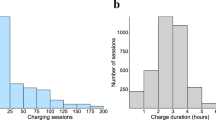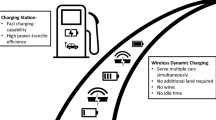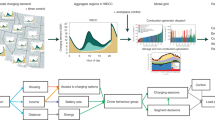Abstract
This study discloses a dataset of electric vehicles’ (EVs’) charging transactions at a scale for multi-faceted analysis from both EV charger and user perspectives. The data comprises whole sessions that occurred during a charging operation company’s annual commercial operation period, specifically including identifiers and charger location categories. For data acquisition, machine-to-machine wireless communication system with proper retransmission for interruption is utilised. The entire dataset is newly collected and is available with 72,856 sessions from 2,337 EV users and 2,119 chargers. The dataset can be used in a variety of ways for the functioning of power systems and markets, including EV charging service businesses, charger installation siting, demand transaction market design, and long-term investment planning of EV-related infrastructure.
Similar content being viewed by others
Background & Summary
To overcome climate change and achieve carbon neutrality, the transportation sector is undergoing an energy load shift, and there have been discussions and proposals in many countries to phase out the production and use of internal combustion engines over the next few decades. For example, targets have been set in Norway to ban new sales of petrol and diesel vehicles by 2025, in the UK by 2030, and in California by 2035, and major vehicle manufacturers have announced plans to eliminate the internal combustion engine and introduce electric or other alternative powertrains in the coming years1,2. In addition, in the EU, all new passenger and commercial cars registered in Europe must achieve zero emission by 2035. As an intermediate step, ‘Fit for 55’, which refers to the reductions of 55% and 50% in carbon emissions for new cars and vans respectively by 2030, was adopted3,4.
Under international consensus, manufacturing systems are being modified to increase the production of electric vehicles (EVs) and sales prices are being reduced to encourage the uptake of EVs without relying on promotions5,6. EV chargers are also being developed and demonstrated to provide services related to power system operations, such as power reserve and volatility response7,8,9. Charging rates and service designs are being considered to reflect the price sensitivity of EV users and the transaction cost characteristics of renewable energy in wholesale electricity markets10,11,12.
On the other hand, there are several concerns within the aforementioned industry sentiment. Firstly, the disproportionate proliferation of EVs dramatically increases the electricity demand on the distributed power system. The power consumed to charge a single EV is comparable to the power consumption of 20 conventional households, and by 2030, the power system energy will be increased globally by 525–860TWh following expected EV penetration rates13,14. In particular, without an analysis of the charging behaviours of EVs, not only is it difficult to utilise them as a demand resource to respond to the variability of renewable energy, but it also adds to the uncertainty of system net load forecasts13,15. Unfortunately, in previous studies, data obtained from just a small number of volunteers under experimental conditions were publicly available with only limited information, as shown in Table 116,17,18,19,20,21.
Furthermore, data-driven behavioural characterisation is required for decision-making and coordination of stakeholders such as manufacturers, charging operators, and power system operators involved in the economic planning of EV and charger proliferation. At the same time, there is a need to improve social awareness of EV user inconveniences22,23,24,25,26. Although methods to generate meaningful data have been studied as shown in Table 227,28,29,30,31,32,33,34,35, the data generated through experiments have clear limitations for an empirical behavioural analysis.
Therefore, in this paper, the authors present a dataset of charging sessions that is large enough to allow for analysis from both the EV charger and user perspectives, specifically including identification information and location categories. To account for seasonality, the data consists of sessions that occurred during the annual commercial operation period. Accordingly, the resulting dataset is a unique and valuable consideration in several analyses, including
-
Service businesses based on customer inconvenience estimates and forecasts and cost-effectiveness calculations, including time-varying charging rates and reservation services
-
Charger installation siting design based on analyses of charger location information
-
Design of power demand transaction markets, programmes, tariffs, and incentives to promote load shifts and respond to renewable energy variability
-
Long-term investment planning for infrastructure, including distribution grids and charging stations
Methods
Data collection process
The line between the charging information system and the charger uses TCP/IP based on machine-to-machine (M2M) wireless communication as shown in Fig. 1. The communication protocol follows the open charge point protocol (OCPP), an industry standard developed for the purpose of operation and maintenance of charging stations in the open charge alliance. The user is identified by entering the RF card tag or unique ID number held by the user. The charger transmits information (membership card tag, charger connection, charging status, charger disconnection, charging error, etc.) acquired in real time to the charging information system at a frequency of 30 seconds. Large data such as firmware installation files and membership information are transmitted to the charger via file transfer protocol (FTP). The communication port is opened and closed according to the time-out interval of the packet. In general, the communication process of sending request and receiving response is configured in a 30-second cycle. In case of communication failures, the process is repeated twice in 15-second cycles, and the charging history and alarm data generated during the communication interruption are separately transmitted to the charging information system through a retransmission-only packet. Figure 2 describes an example of the main operation after the EV couples with the charger and the data communication process during the cycle.
Coupling status estimation between EV and charger
In this study, the vehicle-charger coupling profile of each session is estimated based on the charging start and end times. The time detection information within sessions are converted into daily time-series data with a resolution of 15 minutes, and the data are classified for analysis purposes using the date, location, and de-identified EV and charger information.
Responsiveness to EV charging rates
To extend the utility of the proposed data, the authors present the EV charging tariffs imposed on EV users and charging operators in this study in Tables 3, 436.
Plus DR program
Plus DR is a program introduced to reduce renewable energy curtailment while contributing to system stabilization. If the curtailment is expected, market operators request a demand increment, power consumers voluntarily increase their electricity usage, and renewable energy operators purchase electricity equivalent to excess power generation as shown in Fig. 3.
In order for microgrids to operate independently with renewable energy sources, a reverse DR market, called Plus DR program in South Korea, is being developed that can handle the surplus power generation of renewable energy. For the purpose of participating in the program, the characteristics of EVs and EV chargers in a general transaction environment should be studied from multiple perspectives. Therefore, in this study, data were investigated to estimate the potential for EV participation in the Plus DR program in South Korea.
Data Records
As summarised in Tables 5, 6, the entire dataset consists of 2,337 EV users, 2,119 chargers, and 72,856 sessions37. The dataset is provided in the form of a comma-separated-value (CSV) file. In particular, EV users with IDs recorded as 0 refer to customers in this study who are not subscribed to a commercially operated company. Since the method of preprocessing data is selected and applied according to various research purposes, the authors provided raw data without preprocessing for reuse. As shown in Table 7, the dataset has 16 columns, including ChargingsessionID, UserID, ChargerID, ChargerCompany, Location, ChargerType, ChargerCapacity, ChargerACDC, StartDay, StartTime, EndDay, EndTime, SrartDatetime, EndDatetime, Duration, and Demand. The number of rows corresponds to the number of independent sessions. The data comprise all charging sessions that occurred during commercial operations from September 30, 2021, to September 30, 2022. The dataset has been made publicly available under the creative commons license CC BY 4.0 posted on the figshare repository.
Technical Validation
Missing data
While communication failures can cause entire session events to be lost, no communication failures occurred during this study.
Charger-side coupling statistics
The daily coupling probability for each installation location is estimated as shown in Fig. 4. Chargers installed in residential locations, such as accommodation, apartment, hotel, camping, and resort tend to charge in the evening and later hours. Other locations tend to have charging behaviour during the daytime. As shown in Fig. 5, the patterns for each day of the week are quite similar, with the exception of bus garages, which have a sporadic charging pattern. In addition, company, public institution, and apartment have weekday-weekend patterns. Table 8 shows the statistics of charger usage. On average, the operation rate and charger coupling duration over research periods are 41% and 3 days, respectively.
User-side coupling statistics
Figure 6 shows the average coupling probability of users. The coupling behaviours of 2,337 charging platform subscribers out of the total users are estimated. The characteristics of major users are confirmed by decoupling in the early morning and coupling in the evening. To confirm the representative behavioural characteristics of users, a clustering methodology should be applied such as k-means, self-organizing map, fuzzy clustering, and Markov chain algorithms38. Based on K-means clustering into four groups, as shown in Fig. 7, EV users generally tend to start charging in the evening. Furthermore, the pattern consists of brief charging in the evening or at night, overnight charging, and aperiodic charging. As presented in Table 9 and Fig. 8, the average charging cycle is 3.43 days, and EV users with a charging cycle of one week or less account for 90.71% of the total. The remaining 1,072 users, representing 9.29%, are considered outliers and removed from the analysis. The monthly demand of the users is estimated as described in Table 10 and Fig. 9, with an average charging power consumption of 66.52KW.
Arrival and departure time interval statistics
As shown in Fig. 10, a pattern of spikes in arrival times is confirmed mostly in the morning or evening. The kernel density profile for departure times is similar in shape to the profile of arrival times but was shifted several hours later. The probability density function of departure times for each arrival time is estimated as shown in Fig. 11. During the daytime (05:00–17:00), it can be confirmed that customers generally leave immediately after charging is complete. On the other hand, EVs arriving during the evening (18:00) have a pattern of remaining idle even after charging is complete.
Code availability
The code implementation was done in R 4.1.2 using R studio. The scripts to perform data visualization are available in37.
References
Roadmaps for Energy, The Facts on: Norway’s alleged plan to “prohibit sales of all vehicles using fossil fuels by 2025” https://roadmapsforenergy.eu/norway-fossilfuel-car-ban (2016).
Reuters, UK to ban sale of new petrol and diesel cars from 2030: FT https://www.reuters.com/article/us-britain-autos-idUSKBN27U0D8 (2020).
European Commission, Zero emission vehicles: first ‘Fit for 55’ deal will end the sale of new CO2 emitting cars in Europe by 2035 https://ec.europa.eu/commission/presscorner/detail/en/ip_22_6462 (2022).
ACEA, European EV Charging Infrastructure Masterplan https://www.acea.auto/files/Research-Whitepaper-A-European-EV-Charging-Infrastructure-Masterplan.pdf (2022).
Consumer Reports, Electric cars are becoming less expensive https://www.consumerreports.org/cars/hybrids-evs/electric-cars-are-becoming-less-expensive-a6548270716 (2023).
International Energy Agency, Global EV Outlook 2022 https://www.iea.org/reports/global-ev-outlook-2022 (2022).
U.S. Department of Defense, DoD plug-in electric vehicle program: The DoD V2G pilot project-overview http://electricvehicle.ieee.org/files/2013/03/DoD-Plug-In-Electric-Vehicle-Program.pdf (2013).
de Brey, B. Smart solar charging: bi-directional AC charging (V2G) in the Netherlands. J. Energy Power Eng. 11, 483–490 (2017).
Mwasilu, F., Justo, J. J., Kim, E. K., Do, T. D. & Jung, J. W. Electric vehicles and smart grid interaction: A review on vehicle to grid and renewable energy sources integration. Renew. Sust. Energ. Rev. 34, 501–516 (2014).
Kim, J. D. Insights into residential EV charging behavior using energy meter data. Energy Policy 129, 610–618 (2019).
Lawrence Berkeley National Lab, Electric vehicle rate design overview https://eta-publications.lbl.gov/sites/default/files/ev_grid_assist_ev_rate_design_overview.pdf (2022).
Lawrence Berkeley National Lab, EV retail rate design 101 https://eta-publications.lbl.gov/sites/default/files/ev_tariff_design_101_final.pdf (2022).
Wang, Q., Liu, X., Du, J. & Kong, F. Smart charging for electric vehicles: A survey from the algorithmic perspective. IEEE Commun. Surv. Tutor. 18, 1500–1517 (2016).
Universidad de Navarra, The impact of electric vehicles in household electricity consumption. Initial US configures as a guidance https://www.unav.edu/web/global-affairs/the-impact-of-electric-vehicles-in-household-electricity-consumption.-initial-us-figures-as-guidance (2022).
Vithayasrichareon, P., Mills, G. & MacGill, I. F. Impact of electric vehicles and solar PV on future generation portfolio investment. IEEE Trans. Sustain. Energy 6, 899–908 (2015).
Caltech, ACN-Data https://ev.caltech.edu/dataset.
Ramos, J., Soares, J., Foroozandeh, Z., Tavares, I. & Vale, Z. Energy consumption of 15 electric vehicles (one day resolution). Zenodo https://doi.org/10.5281/zenodo.5106433 (2021).
Asensio, O. I., Apablaza, C. Z., Lawson, M. C. & Walsh, S. E. Replication data for: A field experiment on workplace norms and electric vehicle charging etiquette. Harvard Dataverse https://doi.org/10.7910/DVN/NFPQLW (2020).
Obusevs, A., Domenico, D. D. & Korba, P. One year recordings of electric vehicle charging fleet. IEEE Dataport https://doi.org/10.21227/fkap-fr63 (2021).
U.S. Department of Energy, Electric vehicle charging stations in New York https://data.ny.gov/Energy-Environment/Electric-Vehicle-Charging-Stations-in-New-York/7rrd-248n (2020).
London Borough of Barnet, Electric vehicle charging transactions https://www.data.gov.uk/dataset/16c7326b-57fe-4803-88f8-9286c387f68a/electric-vehicle-charging-transactions (2022).
Fotouhi, Z., Hashemi, M. R., Narimani, H. & Bayram, I. S. A general model for EV drivers’ charging behavior. IEEE Trans. on Veh. Technol. 68, 7368–7382 (2019).
Habibifar, R., Lekvan, A. A. & Ehsan, M. A risk-constrained decision support tool for EV aggregators participating in energy and frequency regulation markets. Electr. Power Syst. Res. 185, 106367 (2020).
Motoaki, Y. & Shirk, M. G. Consumer behavioral adaption in EV fast charging through pricing. Energy policy 108, 178–183 (2017).
Wolbertus, R., Kroesen, M., Hoed, R. & Chorus, C. Fully charged: An empirical study into the factors that influence connection times at EV-charging stations. Energy Policy 123, 1–7 (2018).
Zhang, Z., Chen, Z., Xing, Q., Ji, Z. & Zhang, T. Evaluation of the multi-dimensional growth potential of China’s public charging facilities for electric vehicles through 2030. Utilities Policy 75, 101344 (2022).
Zhang, C., Kuppannagari, S. R., Kannan, R. & Prasanna, V. K., Generative adversarial network for synthetic time series data generation in smart grids. Proc. 2018 IEEE Int. Conf. Commun. Con. Comput. Tech. Smart Grids (SmartGridComm), 29–31 (2018).
Shepero, M. & Munkhammar, J. Data from electric vehicle charging stations: Analysis and model development. Proc. 1st E-Mobility Power Syst. Integr. Sym. 23 (2017).
Flammini, M. G. et al. Statistical characterisation of the real transaction data gathered from electric vehicle charging stations. Electr. Power Syst. Res. 166, 136–150 (2019).
Quirós-Tortós, J., Espinosa, A. N., Ochoa, L. F. & Butler, T., Statistical representation of EV charging: Real data analysis and applications. Proc. 2018 Power Syst. Comput. Conf. (PSCC) 1–7 (2018).
Gadda, S., Kockelman, K. M. & Damien, P. Continuous departure time models: A bayesian approach. Transp. Res. Rec. 2132, 13–24 (2009).
Sadeghianpourhamami, N., Benoit, D., Deschrijver, D. & Develder, C. Bayesian cylindrical data modeling using Abe-Ley mixtures. Appl. Math. Model. 68, 629–642 (2018).
Sadeghianpourhamami, N., Benoit, D., Deschrijver, D. & Develder, C., Modeling real-world flexibility of residential power consumption: Exploring the cylindrical WeiSSVM distribution. Proc. 9th Int. Conf. Future Energy Syst. 408–410 (2018).
Majidpour, M., Qiu, C., Chu, P., Gadh, R. & Pota, H. R. Fast prediction for sparse time series: Demand forecast of EV charging stations for cell phone applications. IEEE Trans. Ind. Informatics 11, 242–250 (2015).
Iftikhar, N., Liu, X. & Danalachi, S. A scalable smart meter data generator using spark. Proc. OTM Confederated Int. Conf. Move to Meaningful Internet Syst. 10573, 21 (2017).
Korea Electric Power Corporation, Electricity tariff structure https://cyber.kepco.co.kr/ckepco/front/jsp/CY/E/E/CYEEHP00209.jsp (2021).
Kim, J. et al. A dataset for multi-faceted analysis of electric vehicle charging transactions. Figshare https://doi.org/10.6084/m9.figshare.22495141.v1 (2023).
Al-Ogaili, A. S. et al. Review on scheduling, clustering, and forecasting strategies for controlling electric vehicle charging: Challenges and recommendations. IEEE Access 7, 128353–128371 (2019).
Acknowledgements
This study was supported by research fund from Chosun University, 2023. Authors appreciate Rosetta Chaewon Kim with FlexWATT Corp. for English editing.
Author information
Authors and Affiliations
Contributions
K. Baek and E. Lee contributed equally to this work. J. Kim managed and supervised this work.
Corresponding author
Ethics declarations
Competing interests
The authors declare no competing interests.
Additional information
Publisher’s note Springer Nature remains neutral with regard to jurisdictional claims in published maps and institutional affiliations.
Rights and permissions
Open Access This article is licensed under a Creative Commons Attribution 4.0 International License, which permits use, sharing, adaptation, distribution and reproduction in any medium or format, as long as you give appropriate credit to the original author(s) and the source, provide a link to the Creative Commons licence, and indicate if changes were made. The images or other third party material in this article are included in the article’s Creative Commons licence, unless indicated otherwise in a credit line to the material. If material is not included in the article’s Creative Commons licence and your intended use is not permitted by statutory regulation or exceeds the permitted use, you will need to obtain permission directly from the copyright holder. To view a copy of this licence, visit http://creativecommons.org/licenses/by/4.0/.
About this article
Cite this article
Baek, K., Lee, E. & Kim, J. A dataset for multi-faceted analysis of electric vehicle charging transactions. Sci Data 11, 262 (2024). https://doi.org/10.1038/s41597-024-02942-9
Received:
Accepted:
Published:
DOI: https://doi.org/10.1038/s41597-024-02942-9














